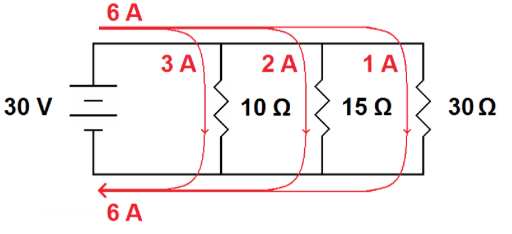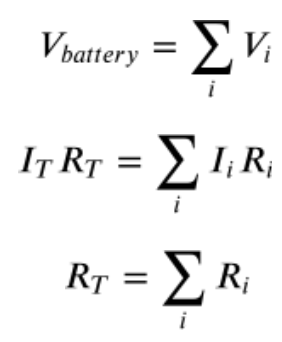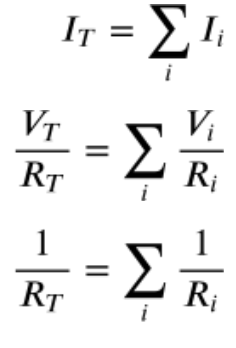
9.4 Kirchhoff’s Junction Rule, Ohm’s Law (Resistors in Series and Parallel)
2 min read•june 7, 2020
Peter Apps
Peter Apps
Enduring Understanding 5.C
The of a system is conserved.
Essential Knowledge 5.C.3
Kirchhoff’s junction rule describes the conservation of in . Since the charge is conserved, the must be conserved at each junction in the circuit. Examples include circuits that combine and parallel.
** For AP 1, you could have a series circuit with 1 parallel branch.
Kirchhoff's Junction Rule follows a similar logic process as the Loop Rule, except with using conservation of charge instead of energy. In the circuit, the charge must be conserved since it’s a closed system. The (rate of charge transfer) must be the same going into and out of a junction since there’s nowhere for the charge to disappear or appear from.
In the example below, the total (6A) is split at each branch, then joined back as the branches merge again. The amount of traveling through each branch is dependent on the resistance of the branch (more resistance = less ).

Both of Kirchhoff’s Laws together allow us to develop new equations for the of series and parallel circuits. Here’s a quick overview of how these equations arise. For a more detailed explanation, check out this site.
Series Circuit: (1 Path)
For a series circuit, there’s only one path. Using the Junction Rule, this means that the must be the same throughout the circuit. The Loop Rule says that the voltages must equal the battery’s voltage. Since V = IR (Ohm’s Law) that means that each voltage drop only depends on the resistance of the component. Therefore the total resistance of a series circuit must equal the sum of each of the individual resistances.

*** Big Idea *** Adding another resistor in series will always INCREASE the of the circuit.
Parallel Circuit: (2+ Paths)
For a parallel circuit, the voltage drop across each branch must be equal to the battery’s voltage (Loop Rule). The Junction Rule tells us that each loop has some fraction of the related to the resistance, but the total must be equal to the sum of each of the branches. Using Ohm’s Law (V = IR) we can expand then simplify our equation.

*** Big Idea *** Adding another resistor in parallel will always DECREASE the of the circuit.
🎥Watch: AP Physics 1 - Unit 9 Streams
Key Terms to Review (7)
Current
: Current refers to the flow of electric charge in a circuit. It is measured in amperes (A) and represents the rate at which charges move through a conductor.Electric charge
: Electric charge is a fundamental property of matter that determines how it interacts with electric fields. It can be positive or negative.Electrical Circuits
: Electrical circuits are pathways through which electric current flows. They consist of interconnected components, such as batteries, resistors, and switches, that allow the flow of electrons.Equivalent Resistance
: Equivalent resistance refers to the total resistance in a circuit when multiple resistors are connected in series or parallel. It is the single resistor that would produce the same amount of current flow as all the individual resistors combined.Kirchhoff's Loop Rule
: Kirchhoff's Loop Rule, also known as Kirchhoff's Voltage Law (KVL), states that the sum of the voltage drops around any closed loop in a circuit is equal to the sum of the voltage sources in that loop.Resistors in Parallel
: When resistors are connected in parallel, they share the same two points of connection and have the same voltage across them.Resistors in Series
: Resistors in series are two or more resistors connected end-to-end, so that the same current flows through each resistor. The total resistance of resistors in series is equal to the sum of their individual resistances.9.4 Kirchhoff’s Junction Rule, Ohm’s Law (Resistors in Series and Parallel)
2 min read•june 7, 2020
Peter Apps
Peter Apps
Enduring Understanding 5.C
The of a system is conserved.
Essential Knowledge 5.C.3
Kirchhoff’s junction rule describes the conservation of in . Since the charge is conserved, the must be conserved at each junction in the circuit. Examples include circuits that combine and parallel.
** For AP 1, you could have a series circuit with 1 parallel branch.
Kirchhoff's Junction Rule follows a similar logic process as the Loop Rule, except with using conservation of charge instead of energy. In the circuit, the charge must be conserved since it’s a closed system. The (rate of charge transfer) must be the same going into and out of a junction since there’s nowhere for the charge to disappear or appear from.
In the example below, the total (6A) is split at each branch, then joined back as the branches merge again. The amount of traveling through each branch is dependent on the resistance of the branch (more resistance = less ).

Both of Kirchhoff’s Laws together allow us to develop new equations for the of series and parallel circuits. Here’s a quick overview of how these equations arise. For a more detailed explanation, check out this site.
Series Circuit: (1 Path)
For a series circuit, there’s only one path. Using the Junction Rule, this means that the must be the same throughout the circuit. The Loop Rule says that the voltages must equal the battery’s voltage. Since V = IR (Ohm’s Law) that means that each voltage drop only depends on the resistance of the component. Therefore the total resistance of a series circuit must equal the sum of each of the individual resistances.

*** Big Idea *** Adding another resistor in series will always INCREASE the of the circuit.
Parallel Circuit: (2+ Paths)
For a parallel circuit, the voltage drop across each branch must be equal to the battery’s voltage (Loop Rule). The Junction Rule tells us that each loop has some fraction of the related to the resistance, but the total must be equal to the sum of each of the branches. Using Ohm’s Law (V = IR) we can expand then simplify our equation.

*** Big Idea *** Adding another resistor in parallel will always DECREASE the of the circuit.
🎥Watch: AP Physics 1 - Unit 9 Streams
Key Terms to Review (7)
Current
: Current refers to the flow of electric charge in a circuit. It is measured in amperes (A) and represents the rate at which charges move through a conductor.Electric charge
: Electric charge is a fundamental property of matter that determines how it interacts with electric fields. It can be positive or negative.Electrical Circuits
: Electrical circuits are pathways through which electric current flows. They consist of interconnected components, such as batteries, resistors, and switches, that allow the flow of electrons.Equivalent Resistance
: Equivalent resistance refers to the total resistance in a circuit when multiple resistors are connected in series or parallel. It is the single resistor that would produce the same amount of current flow as all the individual resistors combined.Kirchhoff's Loop Rule
: Kirchhoff's Loop Rule, also known as Kirchhoff's Voltage Law (KVL), states that the sum of the voltage drops around any closed loop in a circuit is equal to the sum of the voltage sources in that loop.Resistors in Parallel
: When resistors are connected in parallel, they share the same two points of connection and have the same voltage across them.Resistors in Series
: Resistors in series are two or more resistors connected end-to-end, so that the same current flows through each resistor. The total resistance of resistors in series is equal to the sum of their individual resistances.
Resources
© 2024 Fiveable Inc. All rights reserved.
AP® and SAT® are trademarks registered by the College Board, which is not affiliated with, and does not endorse this website.